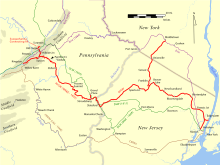
The New Jersey Midland Railway was a 19th-century predecessor to the New York, Susquehanna and Western Railway (NYS&W) that operated in Northern New Jersey and Orange County, New York.

The New Jersey Midland Railway was a 19th-century predecessor to the New York, Susquehanna and Western Railway (NYS&W) that operated in Northern New Jersey and Orange County, New York.

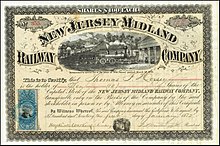
The New Jersey Midland Railway can trace its roots back to the failed New Jersey, Hudson & Delaware Railroad (NJH&D), chartered in 1832 to connect industrial Paterson, New Jersey, east to the ports along the Hudson Waterfront opposite New York City at Hoboken and west to Pennsylvania at the Delaware Water Gap. Though the company did not construct any track, the charter remained active until 1870, and the company cleared a right of way from Sandyston to New York.
In the mid-1860s, several companies were formed to create railroads across northern New Jersey. The earliest of these, the Hoboken, Ridgefield and Paterson Railroad was chartered in 1866 to connect Paterson with the ports along the Hudson River waterfront; various logistical issues ensured this company would not build anything. [2] More successful was the New Jersey Western Railroad, which had built about ten miles of trackage from Hawthorne/Hawthorne (NYS&W station) to Bloomingdale from 1868 to 1870, including the Wortendyke (NYS&W station) before it was consolidated into the NJ Midland. [3] [4]
The New Jersey Midland Railway (NJM) was formed in 1870 as a consolidation of several smaller railroads, including the NJH&D and the NJW. [5] The original plan was to cut through the Hudson Palisades near Englewood and run south along the Hudson River to Weehawken, but the company lacked the money to do so, and instead made arrangements to run through the Pennsylvania Railroad's cut from Marion Junction through Bergen Hill in Jersey City to their Exchange Place Terminal. [2]
In 1871 built west from Two Bridges/Beaver Lake through Sussex County, including construction of the Backwards Tunnel, to the New York state line at Hanford, New Jersey, just south of Unionville, New York. [6] The Ogden Mine Railroad was made obsolete. This was later known as the Hanford Branch.
By 1872 the NJ Midland completed the line between Hackensack and Newfoundland. [7] It also built a line through the Ridgefields by 1872, but with no station. [8] [9] It joined the Erie Railroad Northern Branch at Granton Junction near Babbit, and reached the community of New Durham (near the point now under New Jersey Route 495 where the Susquehanna Transfer had later been located).

The charter for the NJ Midland prevented it from crossing any other railroad to reach the Hudson River, but a route along the foot of the west side of the Bergen Hill to reach the PRR took it across the Erie Railroad. So a new company with the same management, the Hudson Connecting Railway, was formed to build the final leg. With the intention to reach a terminal on the Hudson River, in 1873 the NJM built the Hudson Connecting ROW south to West End Junction [2]
The southernmost part leased from the Erie Railroad's as their original terminus, which had been built as the Paterson and Hudson River Railroad. [10] which accessed Erie's Long Dock Tunnel and Pavonia Terminal. The NJ Midland West End Junction also served as a terminus for the Montclair Railway, which later became the New York and Greenwood Lake Railway. The lease provide access south to the PRR at Marion Junction.
In 1866, public meetings were held in Middletown Westtown and Unionville, New York to discuss the viability of a railroad via these hamlets to Deckertown, Sussex County, New Jersey. A route was surveyed from there to Middletown, but, as built, the Middletown, Unionville and Water Gap Railroad only extended from a connection with the NY&E in Middletown to Unionville, which was reached on December 6, 1867, after fourteen months of construction. [11] Freight cars received from the Erie made the 14-mile (23 km) trip to Unionville starting January 13, 1868. The MU&WG was built to the 6-foot (1.8 m) broad gauge of the Erie. The road was leased to the Erie and commenced regular operations as the Erie's "Unionville Branch" on May 15, 1868. On January 11, 1866, the New York and Oswego Midland Railroad (NY&OM) was incorporated with the goal of linking Oswego, New York, on Lake Ontario, with the Hudson River at a point across from New York City. The NY&OM reached Middletown in 1871 and hoped to connect with three New Jersey companies to form a through route to the Port of New York and New Jersey. The link between the NY&OM and the NJM would be the MU&WG which was leased by the NY&OM effective April 1, 1872. The NY&OM soon entered bankruptcy and dropped the lease on the MU&WG which was then leased by the NJM in 1873. NYS&W and the Middletown and New Jersey Railroad use the line with shared trackage rights. [12]
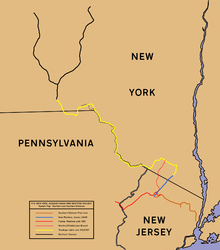
The NJ Midland went bankrupt and was sold to receivers in March 1875. By December 1878, a dispute broke out between various bondholders, some of whom disputed that the Hudson Connecting Railway should be included in the proceedings. [13] On February 21, 1880, the NJ Midland, along with the Hudson Connecting Railway, was sold to Charles Parsons, who represented the bondholders of the first and second mortgages; the two railroads were combined into one.
In June 1881 the NJ Midland was consolidated with five other railroads to form the New York, Susquehanna and Western Railway with Frederic A. Potts and Garret Hobart serving as chief officers. [14] The company expanded west into Pennsylvania along the Wilkes-Barre and Eastern Railroad.
The NYS&W later shifted its mainline to run along the ROW developed by the Lehigh and Hudson River Railway, designating the NJ Midland portion above Sparta Junction the Hanford Branch.
Commuter service ended in 1966, but has been considered for restoration as the part of the Passaic–Bergen–Hudson Transit Project is a project by NJ Transit to possibly reintroduce passenger service on a portion of the NYSW right-of-way (ROW) in Passaic, Bergen and Hudson counties using newly built, FRA-compliant diesel multiple unit rail cars (with stations at Vreeland Avenue and Vince Lombardi Park & Ride, among others. [15] [16] [17]
Existing original station buildings from the NJ Midland era can be found at Bogota, Maywood, Rochelle Park, Wortendyke, Butler, and Newfoundland among other places.

The New York, Susquehanna and Western Railway, also sometimes referred to as New York, Susquehanna and Western Railroad, Susie-Q or the Susquehanna, is a Class II American freight railway operating over 400 miles (645 km) of track in three Northeastern states, New Jersey, New York, and Pennsylvania.

The Main Line is a commuter rail line owned and operated by New Jersey Transit running from Suffern, New York to Hoboken, New Jersey, in the United States. It runs daily commuter service and was once the north–south main line of the Erie Railroad. It is colored yellow on NJ Transit system maps, and its symbol is a water wheel.

The Bergen County Line is a commuter rail line and service owned and operated by New Jersey Transit in the U.S. state of New Jersey. The line loops off the Main Line between the Meadowlands and Glen Rock, with trains continuing in either direction along the Main Line. It is colored on NJT system maps in grey, and its symbol is a cattail, which are commonly found in the Meadowlands where the line runs.

Marion Junction is a railroad junction in western Jersey City, New Jersey. Currently, it connects CSX's River Line to Conrail's Passaic and Harsimus Line. The two lines merge towards the west, allowing through trains from upstate New York to continue towards the rest of the country. The track actually making the connection is known as the Marion Running Track.

For the purposes of this article, the Jersey City area extends North to Edgewater, South to Bayonne and includes Kearny Junction and Harrison but not Newark. Many routes east of Newark are listed here.

The Northern Branch is a railroad line that runs from Jersey City to Northvale in northeastern New Jersey, and formerly extended further into New York State. The line was constructed in 1859 by the Northern Railroad of New Jersey to connect the New York and Erie Railroad's Piermont Branch terminus in Piermont, New York, directly to Erie's primary terminal in Jersey City, initially Exchange Place, later Pavonia Terminal. In 1870 the line was extended to Nyack, New York, and continued to provide passenger service until 1966. After the Erie's unsuccessful merger with the Lackawanna Railroad to form the Erie-Lackawanna, ownership of the line passed into the hands of Conrail upon its formation in 1976 from a number of bankrupt railroads.

The Middletown and New Jersey Railroad is one of two railroads in the city of Middletown, New York; the other being its interchange partner, Norfolk Southern Railway. The MNJ consists of 43 miles (69 km) of track in southeastern New York serving Orange County and the Hudson Valley. The railroad also operates and has trackage rights on three additional branch lines totalling 40 miles (64 km) leased from Norfolk Southern in Orange County. It was known as the Middletown and New Jersey Railway until 2009, when East Penn Railroad parent Regional Rail, LLC bought the line through a new subsidiary. In 2015, Regional Rail was in turn acquired by Levine Leichtman Capital Partners ("LLCP").

The Passaic–Bergen–Hudson Transit Project is a project under study by NJ Transit to reintroduce passenger service on a portion of the New York, Susquehanna and Western Railway (NYSW) right-of-way (ROW) in Passaic, Bergen and Hudson counties using newly built, FRA-compliant diesel multiple unit rail cars. Plans call for service to run from Hawthorne south through Paterson, east to Hackensack and then southeast to North Bergen, where it would join the Hudson-Bergen Light Rail (HBLR).
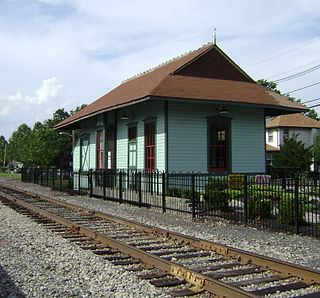
Hawthorne is a former rail station located in Hawthorne in Passaic County, New Jersey. Volunteer Railroaders Association, a non-profit railroad preservation group leases the station from the New York, Susquehanna and Western Railway. The station house is an at-grade single story wooden structure featuring a Dutch gable roof, shiplap siding, and gingerbread trim. It served as the ticket office until June 30, 1966, and was also used as a freight depot building.
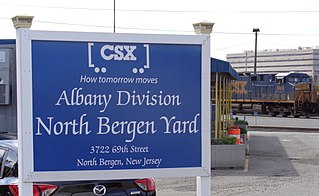
The North Bergen Yard is freight rail yard and intermodal terminal in North Bergen, New Jersey parallel to Tonnelle Avenue between 49th and 69th Streets. Located within the North Jersey Shared Assets Area, the facility is part of CSX Transportation (CSXT) and the origination point of its CSX River Subdivision at the southern end of the Albany Division. On its west side, the New York, Susquehanna and Western Railway (NYSW) runs the length of the yard and operates a bulk transloading operation immediately adjacent to it.
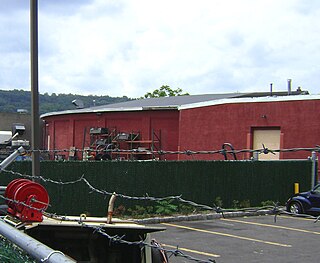
North Hawthorne, known as North Paterson when originally constructed, was a rail station and yard located in Hawthorne, Passaic County, New Jersey. The facility, which was equipped with car and engine shops, served passengers and freight for both the Erie Railroad and the New York, Susquehanna and Western Railroad from 1892 to 1966. Passenger service from North Hawthorne primarily transported commuters to and from the Susquehanna Transfer station in North Bergen or the Erie Railroad's Pavonia Terminal in Jersey City. Connecting service included the now defunct Public Service Railway, which at one time used North Hawthorne as the terminus of a trolley line connecting Hawthorne to Paterson. Once a sizable complex with multiple spurs and sidings for surrounding industries, North Hawthorne has been reduced to a single runaround siding. Every structure associated with the yard has been demolished, except for the roundhouse, which today is owned by private interests.

The Edgewater Branch was a branch of the New York, Susquehanna and Western Railway (NYS&W) that ran about 3.174 miles (5.108 km) through eastern Bergen County, New Jersey in the United States. Starting from a rail junction at the Little Ferry Yard, it went east through the Edgewater Tunnel to Undercliff to the Hudson Waterfront.

Little Ferry Yard is a railyard and intermodal terminal in the Port of New York and New Jersey served by the CSX River Subdivision (CSXT), New York, Susquehanna and Western Railway (NYSW), Norfolk Southern Railway and Conrail Shared Assets Operations (CRCX).

Ridgefield Park station, also known as West Shore Station, was a railroad station in Ridgefield Park, New Jersey, at the foot of Mount Vernon Street served by the New York, Susquehanna and Western Railroad (NYSW) and the West Shore Railroad, a division of New York Central (NYCRR). The New York, Ontario and Western Railway (NYO&W) had running rights along the West Shore and sometimes stopped at Ridgefield Park. First opened in 1872 it was one of three passenger stations in the village, the others being the Little Ferry station to the south and Westview station to the north. Service on the West Shore Railroad began in 1883. The station house, built at a cost $100,000 opened in 1927. Southbound service crossed Overpeck Creek and continued to terminals on the Hudson River waterfront where there was connecting ferry service across the Hudson River to Manhattan. Northbound near Bogota the parallel NYSW and West Shore lines diverge and continue into northern New Jersey, Pennsylvania, and upstate New York. Passenger service ended in 1966.

Vreeland Avenue was railroad station in Paterson, New Jersey served by the New York, Susquehanna and Western Railroad (NYS&W). until 1966. Service by the New Jersey Midland, a predecessor to the NYS&W, had begun in 1873. The station house dates to 1949. Other extant station buildings from the New Jersey Midland/NYSW can be found at Wortendyke, Butler, and Newfoundland, among other places.

Hackensack was a railroad station in Hackensack, New Jersey on the New York, Susquehanna and Western Railway Main Line, which provided passenger service between the 1870s and 1960s. The station at Main and Mercer Streets opened in 1872; it was replaced with one at River Street in 1950. Public Service trolley lines served both stations.

Bogota was a railroad station in Bogota, New Jersey, at Court Street/Fort Lee Road west of River Road and east of the Court Street Bridge over the Hackensack River. It was located on the New York, Susquehanna and Western Railway Main Line, which provided passenger service between the 1870s and 1960s.

Pompton Junction is a former railroad station and active railroad junction in the borough of Pompton Lakes, New Jersey, United States. The station is located on the New York and Greenwood Lake Railway and the New York, Susquehanna and Western Railway, both subsidiaries of the Erie Railroad. Pompton Junction contained two side platforms at a diamond crossing, with a station depot on the Susquehanna Railroad side and a station canopy on the Greenwood Lake side. A railroad tower with the telegraph call letters "PJ" was present on the Greenwood Lake side of the station.

The Vince Lombardi Park & Ride is located on the New Jersey Turnpike in the Meadowlands in Ridgefield, Bergen County, New Jersey. The park and ride and separate service area to south of it are dedicated to and named after Vince Lombardi. Located at the edge of the Little Ferry Yard it has been viewed as a potential rail station location since the 1990s and as of 2021, it is under consideration by NJ Transit as part of the Passaic–Bergen–Hudson Transit Project.

Broadway–Paterson was a New York, Susquehanna and Western Railroad (NYS&W) station in Paterson, New Jersey near the level, or at-grade crossing south of Broadway at Ellison Place and Madison Avenue. Service by the New Jersey Midland, a predecessor to the NYS&W, had begun in 1873. It was originally known as Paterson, but was renamed after a junction of the railroad's mainline was created to build the Paterson City Branch. The station house, demolished in 1982, was situated between the two lines and served as the Susquehanna's headquarters for several years. Passenger service on the branch ended in 1960 and on the mainline in 1966.